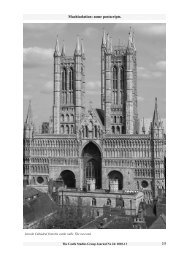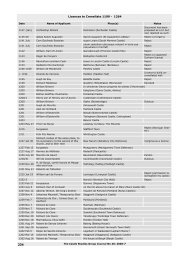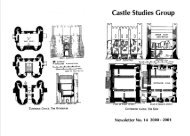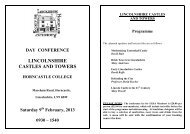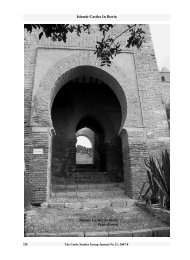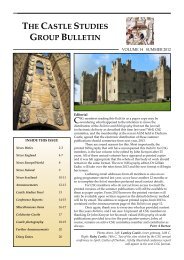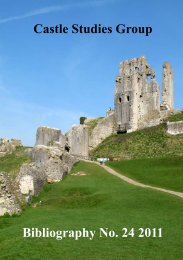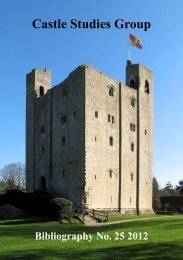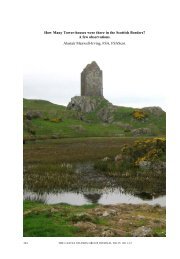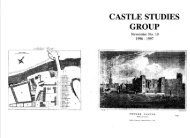Castle Studies Group Bibliography No. 22 2009
Castle Studies Group Bibliography No. 22 2009
Castle Studies Group Bibliography No. 22 2009
Create successful ePaper yourself
Turn your PDF publications into a flip-book with our unique Google optimized e-Paper software.
expected that similar projects would be undertaken at EH sites such as Dover, as those at asenior level charged with progressing such work seem to be ex-HRP staff! However, as thisissue emphasizes, there is more to presentation than the creation of pseudo-medieval apartments(I use the phrase guardedly, not having seen Dover, and bearing in mind work that may happenat Chepstow, as well as what is happening at Stirling – see below).So, in this issue Robert Liddiard examines the problems in the presentation of castles,emphasizing the progress EH has made with its guidebooks and welcoming the improvement inlevels of interpretation through panels (this was reprinted in the last volume of the CSGjournal). One might say where Cadw led, EH has followed, although I am uncertain whetherinterpretation panels are going to have a future at Cadw sites. Andrew Hann looks at thepresentation of the later history of medieval buildings such as Framlingham. Chris Watkins ofHistoric Scotland features the work being undertaken at Stirling <strong>Castle</strong>’s palace, including themanufacture of seven great tapestries, four of which are on display already, with a further threedue for completion by 2013. Other work on the interiors has been undertaken, creating amagnificent idea of what James V’s mid-sixteenth-century palace looked like, and more work isto follow. Two short pieces by Anna Keay, Director of Properties Presentation at EH, are on theElizabethan garden at Kenilworth and the project involving Dover’s great tower, in an attemptto evoke the tower as it was late in the twelfth century.In the latest Château Gaillard Ollie Creighton looks at archaeology and castle studies inEngland, highlighting some of the potentially promising directions that castle research couldtake, at least as far as archaeology is concerned, especially in programmes that are notexclusively castle-centric. <strong>No</strong>table current examples are urban archaeology, designedlandscapes and domestic planning, and in the future more work is needed on castle baileys, thepublication of past excavations, and also the examination of poetic and literary evidence. Therichness of the latter in Welsh poetry is emphasized in an excellent paper in the forthcomingproceedings of the Bangor conference – see Forthcoming publications, below.Ollie Creighton and Robert Liddiard have published a riposte in the recent issue ofMedieval Archaeology to Colin Platt’s paper in the previous volume of this journal. Rather thantake Platt’s comments point by point, it is an expansion of the Château Gaillard piecementioned above. There are strengths to both sides of the argument, of course, and what Platthas done is to remind us that there is more to castles than looking at them in a regional or widerpicture, or even local, as in their ‘designed landscape’, and that the military nature of numerousexamples should not be lost sight of, however, no matter whether the ‘military’ aspect issymbolic as opposed to pure ‘fortress’. Nevertheless, castle studies have undoubtedly beeninvigorated by such works as Liddiard’s <strong>Castle</strong>s in context (2005).Phil Davis contributed another useful paper to our journal on licences to crenellate, withsome additional date, analysis and comment, including a response to Colin Platt’s paper involume 21 of the CSG journal. The sections in Phil’s paper cover various aspects of the issuingof licences, such as expression of royal favour.Penny Dransart’s contribution to the recent Château Gaillard concerns earthwork castles inScotland, including episcopal residences, examining in particular those sites from the latetwelfth to the fourteenth century that had moats. The fourth part of Malcolm Fry’s saga on thepreservation of ancient and historic monuments in Ulster has been published.A handsome three-volume work on the history of British art was published last year by TatePublishing in association with Tate Britain and Yale Center for British Art. The first volumecovers the period from 600 to 1600, and John Goodall’s chapter examines patronage, function5



